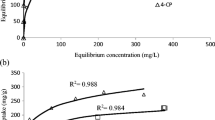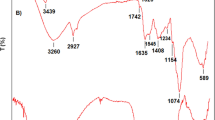Abstract
A microorganism capable of degrading phenol was isolated from crude oil contaminated soil and identified as Pseudomonas fluorescence. A porous polymer bead of polyvinyl alcohol (PVA) and Xanthan gum was found to be the best entrapment for phenol degradation in terms of bead shape (spherical form), bead strength, non-agglomeration, phenol degradation rate, and cell holding inside the bead. Activated carbon was co-immobilized with the microorganism in the bead, which readily adsorbed phenol to decrease initial phenol concentration. Due to the decreased phenol concentration, the cells needed shorter adaptation time after which the microorganism stably degraded phenol. When the bead containing microorganism with 1% of activated carbon was packed in a packed-bed bioreactor, the start-up period was shortened by 40 h and the removal efficiency of phenol during the period was increased by 28% than the case with only microorganism.







Similar content being viewed by others
References
Prieto MB, Hidalgo A, Serra JL, Llama MJ (2000) Degradation of phenol by Rhodococcus erythropolis UPV-1 immobilized on Biolite® in a packed-bed reactor. J Biotechnol 97:1–11
Prpich GP, Daugulis AJ (2005) Enhanced biodegradation of phenol by a microbial consortium in a solid-liquid two phase partitioning bioreactor. Biodegradation 16:329–339
Keith LH, Telliand WA (1979) Priority pollutant. Environ Sci Technol 13:416–423
Karigar C, Mahesh A, Nagennahalli M, Yun DJ (2006) Phenol degradation by immobilized cells of Arthrobacter citreus. Biodegradation 17:47–55
Viggiani A, Olivieri G, Siani L, Donato AD, Marzocchella A, Salatino P, Barbieri P, Galli E (2006) An airlift biofilm reactor for the biodegradation of phenol by Pseudomonas stutzeri OX1. J Biotechnol 123:464–477
Yang R, Humphrey S (1975) A dynamics and steady state studies of phenol degradation in pure and mixed cultures. Biotechnol Bioeng 17:1211–1235
Ozaki H, Liu Z, Terashima Y (1991) Utilization of microorganisms immobilized with magnetic particles for sewage and wastewater treatment. Water Sci Technol 23:1125–1136
Song SH, Choi SS, Park KM, Yoo YJ (2005) Novel hybrid immobilization of microorganisms and its applications to biological denitrification. Enzy Microbiol Technol 37:567–573
Yeom SH, Yoo YJ (2002) Analysis of microbial adaptation at enzyme level for enhancing biodegradation rate of BTX. Korean J Chem Eng 19:780–782
Ehrhardt HM, Rehm HJ (1984) Phenol degradation by microorganisms adsorbed on activated carbon. Appl Microbiol Biotechnol 21:32–36
Yamanaka H, Moriyoshi K, Ohmoto T, Ohe T, Sakai K (2008) Efficient microbial degradation of bisphenol A in the presence of activated carbon. J Biosci Bioeng 105:157–160
Acknowledgment
This research was financially supported by a grant No. RTI05-01–02 from the Regional Technology Innovation Program of the Ministry of Commerce, Industry and Energy (MOCIE). The authors are grateful for the support.
Author information
Authors and Affiliations
Corresponding author
Rights and permissions
About this article
Cite this article
Kwon, K.H., Jung, KY. & Yeom, S.H. Comparison between entrapment methods for phenol removal and operation of bioreactor packed with co-entrapped activated carbon and Pseudomonas fluorescence KNU417. Bioprocess Biosyst Eng 32, 249–256 (2009). https://doi.org/10.1007/s00449-008-0245-1
Received:
Accepted:
Published:
Issue Date:
DOI: https://doi.org/10.1007/s00449-008-0245-1




